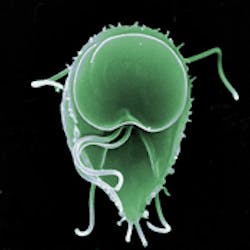Giardia Parasite Enjoys Lengthy History of Human Illness
Giardia lamblia is one of the most common human parasites in the United States, causing more than 20,000 intestinal infections each year.
A complete genetic sequence of this parasite now suggests it had ancestors reaching back more than a billion years.
Giardia is a eukaryote, one of a diverse bunch of organisms made up of cells with a nucleus that contains genetic material. But Morrison believes its molecular machinery appears too simple to have evolved from more modern and complex eukaryotes.
"It is about the size of a yeast genome, which was one of the earliest eukaryote genomes to be sequenced and has about 6,000 genes," said Hilary Morrison, of the Marine Biological Laboratory in Woods Hole, Massachusetts. In comparison, the genome of humans, who are also eukaryotes, contains about 20,000 genes.
The evolutionary story of this parasite will likely become clearer as new genomes are sequenced, but the Giardia genome can offer more immediate insights in the search for more effective treatments for giardiasis.
Spread through oral-fecal contact, giardiasis often strikes children in day-care centers where diapers are changed. It can also infect swimmers who swallow contaminated water.
In the intestine, Giardia swims and feeds, causing gas, diarrhea and discomfort until it is finally expelled through the stool. The whole unpleasant affair can last anywhere from two to six weeks, but some people can have the infection without these symptoms.
In the environment, Giardia takes the form of an infectious cyst that can survive for weeks in water, soil, food and other surfaces.
Many people need no treatment for giardiasis, but prescription drugs are available. "The problem now is people are getting treatment resistance," Morrison said.
That is where the genome study should prove most useful.
"By having the genome and knowing all the proteins in it, people who develop drugs can look at those and develop good candidates," she said.
CAPTION: A Giardia lamblia trophozoite, in the form the parasite takes while living in the intestine of a human or other animal, is seen in a scanning electron micrograph false color image.
Source: REUTERS, Joel Mancuso, University of California, (Berkeley)
